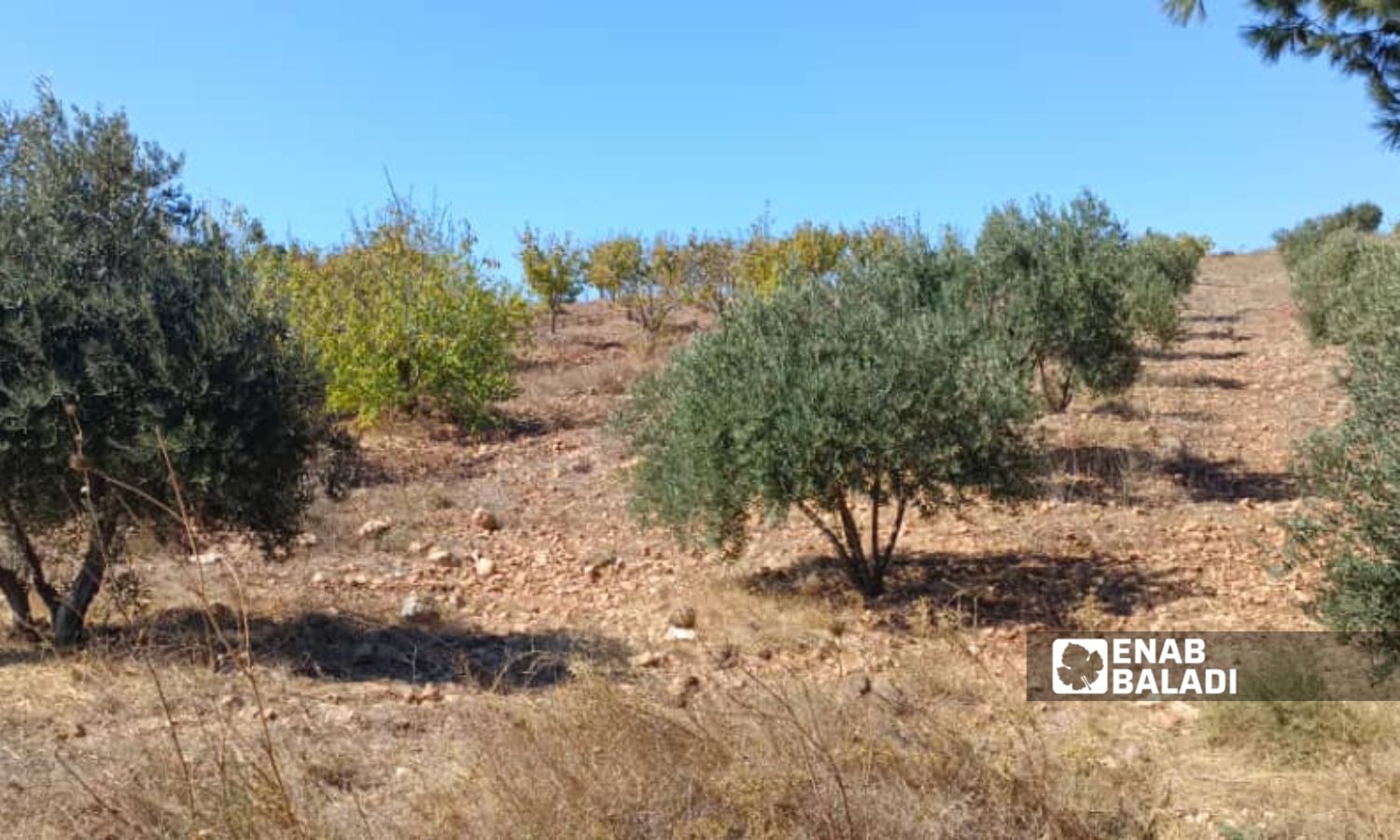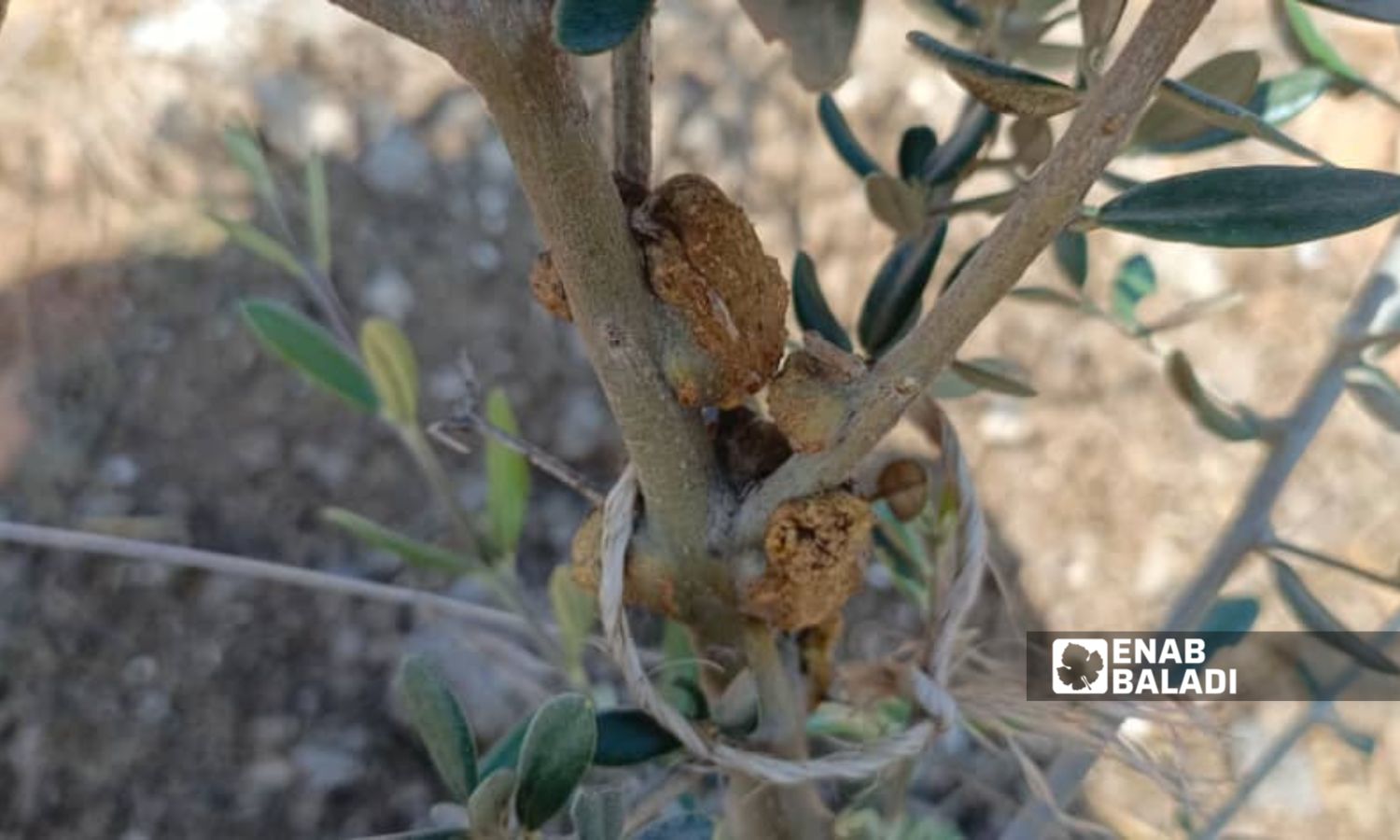



Quneitra – Zain al-Joulani
Olive knot or olive tuberculosis is a new disease that farmers have not encountered before, affecting olive trees in Quneitra governorate in southern Syria. It is a fungal disease that manifests on trees as fibrous knots.
The knots accumulate on the branches, leaves, and the main trunk of the tree down to its roots, according to farmers in the area who spoke to Enab Baladi.
Farmers from the countryside of Quneitra reported that olive knot has affected some of their trees, leading to losses in their crop.
Saddam reported last year the spread of the olive knot disease, which struck a large portion of his trees. He owns 30 dunams planted with olives, which prompted him to contact the advisory unit in his town. He was able to reach an agricultural engineer working in the unit, who guided him on how to treat his trees with agricultural pesticides.
The farmer added that he removed the affected parts by cutting them off and whitewashed the trunks of the trees to prevent further infections.
As another step, the farmer plowed the land after confirming that there was no moisture in the soil, noting that the condition of the trees improved after taking these measures.
For his part, Abu Samir al-Sadi, a farmer who owns olive land in northern Quneitra, told Enab Baladi that the production of olive trees decreased this year due to olive knot, as the fruits dropped from the trees before ripening. He also mentioned that the remaining fruits on the branches developed fibrous knots due to the disease.
He added that he started harvesting this year’s season early due to the fruit drop, as production declined to less than half compared to last year because he could not address the disease affecting his trees, without knowing the treatment methods.
Olive knot is a fungal disease affecting the branches and trunk of trees, appearing as smooth, green fibrous knots that gather on the branches.
The size of the knots ranges from one to five centimeters, according to Mohamed Dahouk, an agricultural engineer from Quneitra, who recommended prompt treatment of the disease before it reaches the roots, leading to the death of the tree.
The engineer added that over time, as the infection progresses, the color of the knots on the trees turns dark brown, leading to the trees drying out and stiffening, eventually reaching the main trunk and then the roots, culminating in their death if swift treatment is not available.
He pointed out that the fungal disease manifests as knots that attach and grow on the branch, preventing the supply of nutrients through it. As time passes, the knots begin to secrete bacteria that quickly spread to neighboring trees through rain, air, and tools typically used for pruning trees.
Bacteria spread during high humidity, which is often associated with climate changes, particularly in Quneitra governorate.
The engineer emphasized that the disease is treated by spraying pesticides, especially those containing copper sulfate and Bordeaux mixture, stressing the necessity of removing the affected parts and the knots formed on the branches, and applying copper sulfate to the areas of the knots.
He considered that removing and burning the tree if it is small is essential if the disease has spread to different parts of it, and it is important to sterilize the site before replanting a new sapling.

Fibrous knot on one of the branches of an olive tree in Quneitra, southern Syria – October 20, 2024 (Enab Baladi/Zain al-Joulani)
The Ministry of Agriculture in the Syrian regime’s government estimated the average production of olives for the current year at 740,000 tons, a 6% increase over last year’s season.
According to estimates published by the government Al-Baath newspaper, 20% of the current season’s production will be table olives, while more than 80% will be for oil extraction.
The head of the Olive Office at the Ministry of Agriculture, Abeer Jawhar, stated in a press statement that the area occupied by olive trees in Syria is estimated at around 674,000 hectares, making up 12% of the cultivated area, with 101 million trees, of which about 90 million are productive.
Last year, olive production in Syria experienced a decline of approximately 28% compared to 2022, due to several reasons, including alternate bearing, drought as a consequence of climate changes, a lack of services, and the rise in wages of laborers, as well as the increased costs of production inputs for farmers, including harvesting, oil extraction, packaging, and fertilizers, among others.
if you think the article contain wrong information or you have additional details Send Correction